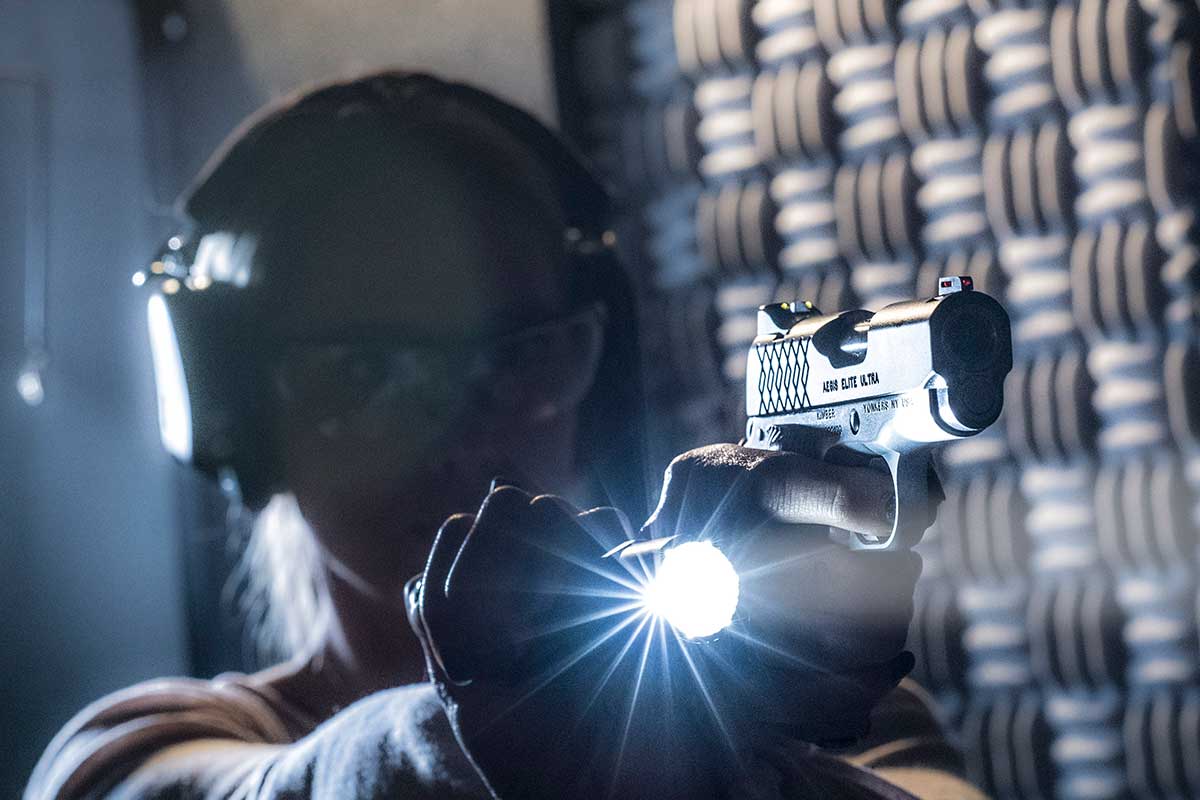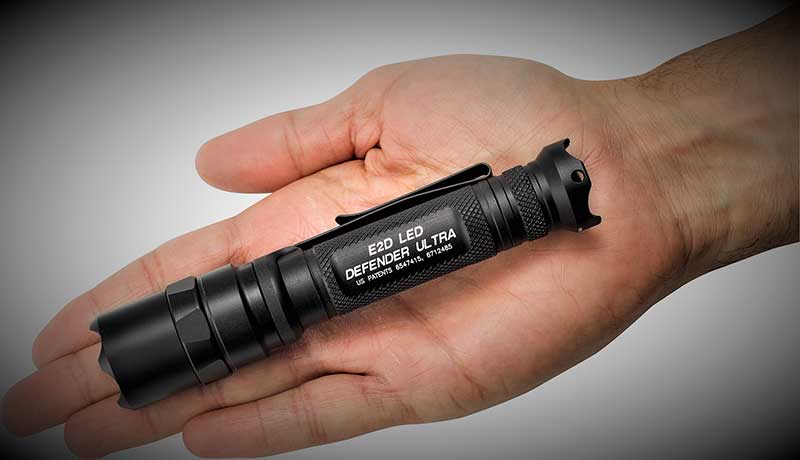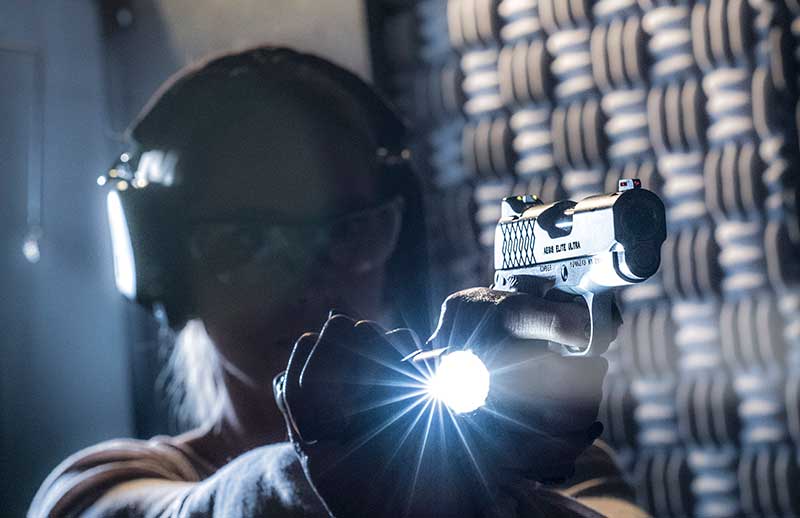
AC-101921-LL-1-800
If you ever have to use your firearm in self-defense there is a very strong likelihood that it will be in low or diminished light. You can’t afford to make any mistakes.
The time frame in which the you will perceive danger to when deadly force is deemed necessary will typically be under a fraction of a second. You need adequate light to locate, identify, evaluate and, if necessary, engage threats.
A research study conducted by the Los Angeles Police Department found that officers have difficulty in distinguishing between lethal and non-lethal objects in levels of light less than that produced by 0.5 foot candles—routine working conditions at night.
And keep in mind these are highly trained officers. The average citizen will likely do much worse. And even during the day, there are many situations in which you will face conditions of reduced or inconsistent lighting.
To make matters worse, your visual acuity will be further reduced by the fact that you and the bad guy will frequently be in motion prior to and during a shooting and the effects of stress and fear also adversely affect your visual acuity. Hormones are secreted by the body during periods of high stress or acute fear that dramatically decrease visual functioning.
NEED FOR WHITE LIGHT
The best way to handle danger is to avoid it in the first place. When this is impossible, the best way to handle danger is to stay ahead of the reaction curve.
You don’t want an assailant to have the jump on you. And you can’t fight what you don’t see. In a lethal force encounter you can’t afford to make a mistake. In conditions of low-light, a powerful white light makes this possible.
Tritium night sights, a red dot optic or a laser will greatly aid shot placement, but you first need to see the threat. Not only will a white light be essential for illumination, it will also provide you with a significant tactical advantage when employed in a tactically sound manner.
The application of high-intensity white light can impair the vision of anyone looking directly into the beam and temporarily disorient that individual, providing you with a critical edge. A powerful light can provide a non-lethal force option and reduce the level of force that’s necessary.

A small tactical flashlight is one of the most useful and versatile tools for personal defense that anyone can carry. It helps identify threats, momentarily disorients attackers, and can be used as an impact weapon.

A tactical flashlight may also serve as an improvised impact weapon. Some flashlights, such as the SureFire E2D Defender shown, feature a crenellated strike bezel to enhance their capability in this regard. The E2D also features a scalloped tail cap.

There’s no excuse not to carry a flashlight. The SureFire Stiletto rechargeable, multi-output flashlight shown is designed for every day carry. It features a slim design with pocket clip that allows it to be easily carried in a pocket like a knife and quickly drawn and activated.
WEAPON-LIGHTS VS FLASHLIGHTS
Flashlights and weapon-lights each have their individual advantages, as well as limitations. Each has its place. Many individuals choose to carry both so they have options.
Manipulating both a flashlight and a weapon can be difficult if not impossible in fast-moving, high-stress situations. It also ties up both hands, one hand to hold and operate the light and the other hand to control and operate the weapon.
Placing your flashlight under your armpit to free up your hand is less than optimal. And should you drop the flashlight, you’re suddenly without a light. A lanyard or a retention ring may be employed to help mitigate these issues.
These problems don’t exist with a weapon-light. A weapon-light will provide you with white light in critical reduced light situations without adversely affecting your ability to shoot, while allowing you to maintain a free hand for other tasks. And since the light is mounted on the weapon, the light is always aligned with the weapon.
Basically a non-issue for home defense, it’s a very real concern for concealed carry.
Although technological advances have led to ultra-compact weapon-lights suitable for concealed carry applications, the added size and weight still need to be considered for concealed carry. The bigger and heavier a handgun is the less concealable it will be and the less likely it will be carried on a daily basis.
Having a weapon-light doesn’t eliminate the need to carry a flashlight. A flashlight is still essential for general illumination tasks and as a backup. A weapon-light is part of the weapon system and needs to be treated as such. It’s an adjunct to a flashlight—not a replacement for it.
If you’re not justified in drawing and pointing your gun, you’re not justified in pointing a weapon-light. A flashlight allows you to safely assess the situation without pointing your gun at a non-threat.

Having the right equipment is only part of the equation. Low-light training and practice is essential. Pistol is Kimber Aegis Elite Ultra.

A weapon light is part of the weapon system. It’s an adjunct to a flashlight and not a replacement for it. SureFire XSC WeaponLight and SIG SAUER ROMEOZero red dot optic shown on SIG SAUER P365XL is a potent fighting combination.
VERSATILE TOOL
Although not its primary purpose, a tactical flashlight may also be employed as a less-lethal impact weapon. It can be used in a similar manner as a Kubotan®, yawara or koppo stick. It has the additional advantage that it may be carried anywhere, including non-permissive environments where weapons may not.
A simple technique that’s suitable for the untrained, is to light up the assailant’s face to temporarily disorient him and then strike his face as hard as you can with the bezel.
Even if you aren’t carrying a gun or plan on using flashlight for self-defense, it’s still one of the most useful and versatile everyday carry tools that you can have with you.
A flashlight should always be in your hand anytime you are navigating in potential diminished lighting scenarios where any threat may be present or hiding.
SUMMING IT UP
As is so often stated, control the light, win the fight. While many factors play into outcomes, you want to do everything that you can to put the odds in your favor. Dominate and control whatever you can. Always carry a flaslight.














